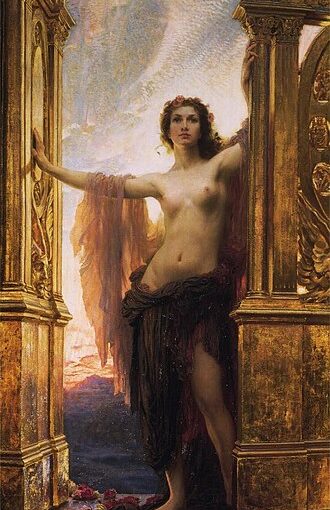Herbert James Draper painted women as if they were moments of revelation. Born in 1864, this English artist spent his career weaving mythological grandeur into intimate human portraits, and nowhere is this more apparent than in The Gates of Dawn, completed in 1900.
The painting measures 198 by 101 centimeters, oil on canvas, and it captures something essential about its moment in history. When Draper exhibited it at the Royal Academy of Arts that same year, the world stood at the threshold of a new century. The painting breathes that sense of possibility. Its central figure, a luminous woman bathed in golden light, seems to embody the promise of what was coming: a century that would belong, in many ways, to women themselves.
This was no accident. Women were beginning to claim spaces previously denied them. They were fighting for education, for university seats, for recognition. Draper sensed this shift and channeled it through the language he knew best: classical mythology.
The ancient Greeks had given Europe a vocabulary of powerful female figures. Goddesses and heroines populated their stories, and these myths had become so embedded in educated culture that Draper could paint Eos, the goddess of dawn, and trust his audience to understand. Homer called her “rosy-fingered,” a phrase that has echoed through literature for millennia. Ovid described her rising from “the shining doors of her rose-filled chamber,” words that seem to describe Draper’s canvas directly.
Eos was the sister of Helios, the sun god, and in Homer’s telling she accompanied him across the sky each day, tireless until sunset. Her story carried weight beyond mere sunrise. One myth tells how she fell in love with Tithonus and begged Zeus to make him immortal. Zeus granted the wish, but Eos forgot to ask for eternal youth. Tithonus aged forever, eventually shrinking into a cicada, a creature of endless song but diminishing substance. It’s a story about desire and consequence, about how even gods can overlook what matters most.
In The Gates of Dawn, Draper captures the goddess at her most transcendent moment. Light spills across the canvas, warm and golden, pushing back against darker tones that suggest the fading night. The technique is chiaroscuro, that dramatic interplay of light and shadow that gives paintings their emotional depth. Here it does more than create visual drama. It makes the transition from darkness to light feel like both a physical and spiritual event.
The figure herself seems to float in this luminous space, neither fully of the night nor completely of the day. There’s something dreamlike about her presence, something that invites you to see dawn not just as a time on the clock but as a metaphor for change, for new beginnings, for moments when everything shifts.
The model was Florence Bird, known as Florrie, one of London’s most sought-after artists’ models at the turn of the century. She had the versatility to embody different characters, and she appeared in several of Draper’s works. In his 1903 Prospero Summoning Nymphs and Deities, she became a water nymph. Before that, in 1898, she appeared in The Lament for Icarus. She was part of a circle of professional models Draper relied on, including the Torr sisters from Clerkenwell and Ellen Wellsted, who posed as classical goddesses like Juno and Demeter.
Draper had a type. He preferred slender builds, defined cheekbones, sharp features. These were the aesthetic standards of late Victorian England, and he worked within them. Sometimes his wife modeled for him, including for a ceiling painting at the Royal Naval College in Greenwich where she appeared as the goddess Amphitrite. He also painted portraits outside the mythological realm: Sir William Edmund Franklyn, actress June Tripp, figures who wanted to be remembered.
But The Gates of Dawn remains different. It’s not just a portrait or a mythological scene. It’s a threshold moment, captured in paint. The goddess stands at the gates, neither fully in one world nor another, and the light that surrounds her feels like both an ending and a beginning.
The painting now hangs in Draper’s Hall in London, in the Drawing Room, where it continues to mark that liminal space between darkness and light, between what was and what might yet be.
Your donation, no matter the size, helps sustain authentic research, creative writing, and the spirit of sharing that connects us all. Let yourself relax and click below to show your support.
